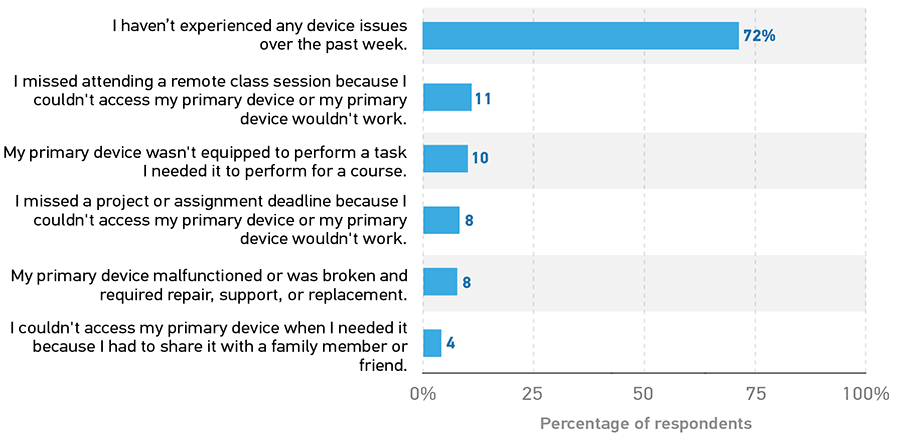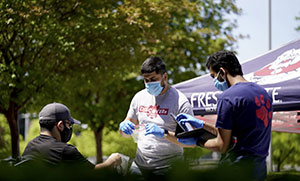Some Devices Aren’t Up to the Task
Nearly all students have access to devices for school, but not all devices can handle the demands of remote learning. Ninety-nine percent (99%) of students reported having access to a reliable device that meets most or all of their academic needs. Most (76%) told us those devices were laptops; 18% said they primarily use a desktop for their school work, and 3% said they primarily rely on a cellphone.
When we asked respondents if they had experienced particular issues with their devices that impacted their schoolwork over the past week, nearly thee-quarters reported having no problems. Relatively small proportions said they missed classes or deadlines because their device didn't work or wasn't equipped for a needed task (figure 4).

When students shared stories of recent device issues they had, many talked about the challenges of using devices that were outdated and/or unable to support the kinds of software and apps required for their courses, as well as having to share devices with other household members.
- "My laptop is very, very old. I do not have money for a new or used one, and it is extremely slow. I have trouble opening up my classes, viewing lectures, downloading lectures or material, and can never hand my assignments in on time even if I finish them before the deadline because my laptop is so slow it takes forever to upload work. This makes me extremely frustrated and upset because I feel ashamed and as though I can't convey this to my professors without seeming like I am not trying to fix my own problems. I hate working with this laptop and I can't afford an alternative, so it has made online learning so stressful and I am extremely behind due to this."
- "I am sad. My last course required three apps at once…with only 8GB of RAM on my Microsoft laptop, it was not possible to see the teacher and follow each and every step he required…I dropped the course and lost money after 3–4 weeks…this course required Photoshop, Zoom, and a photo editor app running simultaneously."
- "My laptop would not work with the Respondus Lockdown Browser that was required for my class exam so I could not take the exam."
- "My device is being shared with my 5 kids, 3 of which my device assists with their online school classes and the other 2 kids may watch videos and play games. This hinders my 3rd year of college doing a bachelor in education."
Some students told us that before the pandemic they could work around some of their device issues by going to campus and using computers and specialty software provided by their institutions. But with campus closures and the move to working/learning from home, these resources are limited or altogether unavailable for many. Before the pandemic, one study found that 20% of undergraduate students had problems maintaining access to technology1 ; and now this "under-connectedness"2 (e.g., slow internet, gaps in connectivity, inadequate hardware) is proving even more difficult for students to manage.
Peers You Can Connect With

Doubling Down and Scaling Up in a Time of Crisis
California State University, Fresno
The DISCOVERe Mobile Technology Program at California State University, Fresno is a bold initiative started in 2014 with the mission of giving all students an opportunity to leverage technology in their classes and providing equitable access to tablets and mobile technology for all. As the pandemic hit, the DISCOVERe team rapidly doubled their efforts by purchasing more mobile devices so any student who needed a device would be provided with one. Recognizing that not all students had access to high-speed internet, the team also purchased thousands of hotspots and provided them to students in need so they could participate in their coursework. The program saw a major uptick in the number of requests for equipment after the emergency move to remote learning, as many students realized the limitations of their own devices and internet access. Meeting the moment, the dedicated DISCOVERe Hub team (many students themselves) organized a minimal-contact, drive-thru equipment pick-up system and an overnight mail service for those who didn't live in the area to help bridge the digital divide for their students.
Notes
-
Amy L. Gonzales, Jessica McCrory Calarco, and Teresa Lynch, "Technology Problems and Student Achievement Gaps: A Validation and Extension of the Technology Maintenance Construct," Communication Research 47, no 5 (August 31, 2018): 750–770.
↩︎ -
Vikki S. Katz, "What It Means to Be 'Under-Connected' in Lower-Income Families," Journal of Children and Media 11, no. 2 (March 24, 2017): 241–244.
↩︎